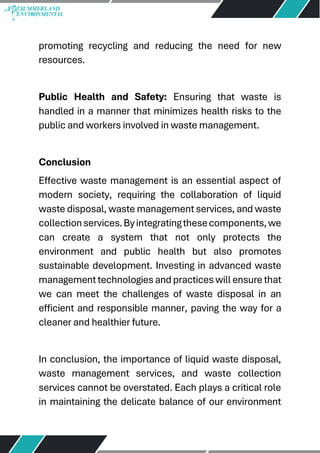About Reclaim Waste
About Reclaim Waste
Blog Article
Indicators on Reclaim Waste You Should Know
Table of ContentsReclaim Waste Can Be Fun For EveryoneReclaim Waste for DummiesThe Best Strategy To Use For Reclaim WasteThe Buzz on Reclaim WasteFacts About Reclaim Waste Revealed
Explore the kinds, events, and forms of fluid waste. Domestic sewage waste refers to the waste and products from a domestic septic system. This sort of waste is produced by human beings in homes, colleges, and other structures. This only includes septic systems that have a drain area. The appropriate management and disposal of domestic sewer waste need fluid waste to be transferred to a sewer treatment plant where the appropriate approaches and equipment are used to detoxify and throw away waste.
Industrial waste usually includes prospective dangers, such as combustible materials or a mixture of liquid and solid waste products, and requires a much more advanced and detailed disposal procedure. The disposal of business waste commonly includes the filtering of waste prior to transport to guarantee secure and correct disposal. Industrial waste is produced from byproducts and overflow of industrial procedures and production.
This kind of waste can not utilize the very same sewage management transportation or processes as septic or commercial liquids. The commercial waste management procedure requires the inspection and screening of liquid waste before it goes through the disposal process (liquid waste disposal). Overflow waste is the fluid waste that comes from runoff and excess stormwater in extremely populated locations or cities
Drainage waste can cause contamination and flooding if not handled effectively. Discover more regarding drain cleansing and waste administration. Making sure correct waste monitoring can avoid calamities and reduce ecological injury. Both people in household settings and experts in business or production sectors can benefit from recognizing the processes and guidelines of fluid waste administration.
The 8-Minute Rule for Reclaim Waste
Contact PROS Providers today to find out concerning our waste monitoring and disposal solutions and the proper ways to take care of the liquid waste you produce.
(https://www.intensedebate.com/people/reclaimwaste1)Do you understand what takes place to your water when you end, flush the commode or drain the cleaning machine? No? Well, it's worth knowing. This supposed 'wastewater' is not just a vital source yet, after treatment, will be released to our land, rivers or the ocean. Used water from toilets, showers, baths, kitchen area sinks, laundries and industrial processes is called wastewater.

water utilized to cool machinery or clean plant and equipment). Stormwater, a form of wastewater, is runoff that flows from agricultural and metropolitan locations such as roofings, parks, yards, roadways, paths and seamless gutters into stormwater drains, after rain. Stormwater flows neglected directly to regional creeks or rivers, ultimately getting to the sea.
The 15-Second Trick For Reclaim Waste
In Queensland, the majority of wastewater is treated at sewage therapy plants. Wastewater is moved from domestic or commercial sites via a system of sewage systems and pump terminals, recognized as sewerage reticulation, to a sewer therapy plant.
The Division of Natural Resources recommends regional federal governments about handling, operating and maintaining sewerage systems and therapy plants. In find this unsewered areas, city governments may need householders to install private or home sewage therapy systems to deal with domestic wastewater from bathrooms, kitchens, bathrooms and laundries. The Department of Natural Resources authorizes the usage of house systems when they are proven to be efficient.
A lot of stormwater receives no therapy. In some brand-new communities, treatment of some stormwater to eliminate clutter, sand and crushed rock has actually started making use of gross toxin traps. Wastewater therapy occurs in four stages: Gets rid of strong issue. Bigger solids, such as plastics and various other things mistakenly released to sewage systems, are gotten rid of when wastewater is passed through screens.
Uses little living microorganisms understands as micro-organisms to damage down and remove remaining dissolved wastes and great particles. Micro-organisms and wastes are included in the sludge.
The Definitive Guide for Reclaim Waste
Nutrient removal is not offered at all sewage therapy plants due to the fact that it requires costly specialised tools. Clear fluid effluent generated after therapy might still contain disease-causing micro-organisms - liquid waste disposal.

A lot of wastewater flows right into the sewage system. Under the Act, neighborhood federal governments provide authorizations and licences for ecologically relevant tasks (Periods) involving wastewater launches that could have a neighborhood impact.
The 3-Minute Rule for Reclaim Waste
Monitoring offers accurate information concerning water top quality and can validate that permit conditions are being satisfied. The info gotten with surveillance provides the basis for making water high quality choices.
Report this page